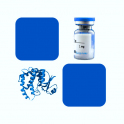
- Remove this product from my favorite's list.
- Add this product to my list of favorites.
Products
Viewed products
Newsletter
 |  |  |  |  |  |

Background
4-1BB is also known as CD137, tumor necrosis factor receptor superfamily member 9 (TNFRSF9), induced by lymphocyte activation (ILA), is a co-stimulatory molecule of the tumor necrosis factor (TNF) receptor superfamily. CD137 can be expressed by activated T cells, but to a larger extent on CD8 than on CD4 T cells. In addition, CD137 expression is found on dendritic cells, follicular dendritic cells, natural killer cells, granulocytes and cells of blood vessel walls at sites of inflammation. The best characterized activity of CD137 is its costimulatory activity for activated T cells. Crosslinking of CD137 enhances T cell proliferation, IL-2 secretion survival and cytolytic activity. Further, it can enhance immune activity to eliminate tumors in mice. CD137 can enhance activation-induced T cell apoptosis when triggered by engagement of the TCR/CD3 complex. In addition, 4-1BB/4-1BBL co-stimulatory pathway has been shown to augment secondary CTL responses to several viruses, and meanwhile augment anti-tumor immunity. 4-1BB thus is a promising candidate for immunotherapy of human cancer. CD137 has been shown to interact with TRAF2.
Source
Recombinant Mouse 4-1BB / TNFRSF9 Protein, His Tag (41B-M52H7) is expressed from human 293 cells (HEK293). It contains AA Val 24 - Leu 211 (Accession # NP_001070976.1).
Predicted N-terminus: Val 24
Molecular Characterization
This protein carries a polyhistidine tag at the C-terminus.
The protein has a calculated MW of 21.9 kDa. The protein migrates as 35-45 kDa under reducing (R) condition (SDS-PAGE) due to glycosylation.
Endotoxin
Less than 1.0 EU per μg by the LAL method.
Purity
>95% as determined by SDS-PAGE.
Formulation
Lyophilized from 0.22 μm filtered solution in PBS, pH7.4 with trehalose as protectant.
Reconstitution
Please see Certificate of Analysis for specific instructions.
For best performance, we strongly recommend you to follow the reconstitution protocol provided in the CoA.
Storage
For long term storage, the product should be stored at lyophilized state at -20°C or lower.
Please avoid repeated freeze-thaw cycles.
This product is stable after storage at:
-20°C to -70°C for 12 months in lyophilized state;
-70°C for 3 months under sterile conditions after reconstitution.
Bioactivity
Please refer to product data sheet.
(1) "GXMR-CAR containing distinct GXM-specific single-chain variable fragment (scFv) mediated the cell activation against Cryptococcus spp. And had difference in the strength of tonic signaling"
Machado, Dos Santos, Guimarães et al
Bioengineered (2023) 14 (1), 2281059
(2) "Immunological and senescence biomarker profiles in patients after spontaneous clearance of hepatitis C virus: gender implications for long-term health risk"
Martín-Escolano, Vidal-Alcántara, Crespo et al
Immun Ageing (2023) 20 (1), 62
(3) " CAR T-cell design-dependent remodeling of the brain tumor-immune microenvironment modulates tumor-associated macrophages and anti-glioma activity"
Haydar, Ibañez-Vega, Crawford et al
Cancer Res Commun (2023)
Showing 1-3 of 1731 papers.
Recombinant human CD40 / TNFRSF5 Protein, Fc Tag (HPLC-verified), 100µg - 409,50 €
Recombinant Cynomolgus / Rhesus macaque B7-1 / CD80 Protein (MALS verified), His tag, 100µg - 383,50 €
Recombinant Mouse CD40 / TNFRSF5 Protein, His-Tag, 100µg - 390,00 €
Recombinant Biotinylated Human CD40 / TNFRSF5, Avi Tag (Avitag™), His tag, 25µg - 487,50 €
Follow us